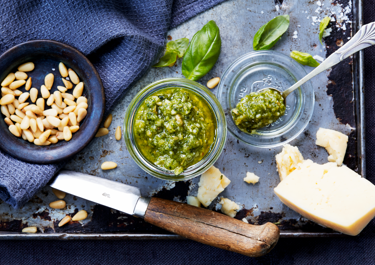Pesto

Homemade pesto alla Genovese is a delicacy that takes your pasta game to the next level. It’s quick and easy to make and with high-quality ingredients you will get a perfect result every time.
Ingredients
Pesto
|
25 g
Pine nuts
|
|
|---|---|
|
1 bunch
Or roughly 20 g fresh basil
|
|
|
2
Garlic cloves
|
|
|
100 ml
Oil
|
|
|
100 g
Svecia cheese
|
|
|
¼ tsp
Salt
|
|
|
1 pinch
Pepper
|
Instructions
Pesto
What is the difference between pesto and pesto Genovese?
Pesto is a thick, roughly ground sauce, traditionally served with pasta. It hails from the city of Genoa in the north Italian region of Liguria, where it’s traditionally made with basil, pine nuts, and parmesan cheese. This green pesto is the famous pesto alla Genovese. Over the years, this delicacy has inspired a number of pesto sauces, made with a wide variety of ingredients. The default pesto is still Genovese, though.
What does pesto mean in Italian?
Pesto is Italian for pounding or crushing. In this sense, any sauce made by crushing ingredients with a mortar and pestle can be considered a pesto. Traditionally, the green pesto alla Genovese is made by grinding the ingredients together using a mortar and pestle, a technique that releases and melds the different flavours in the sauce in an unparalleled way.
What is pesto traditionally served with?
In Italy, the birthplace of pesto, it’s traditionally served with pasta as primo piatto, the “first plate” served after the antipasto and before the secondo or main course. The pasta, preferably freshly made trofie, spaghetti, or other suitable shapes, is tossed with pesto and served warm.
How do Italians eat pesto?
Italian cuisine is all about showcasing a few simple, elegant ingredients that complement and heighten each other. According to this philosophy, the unique marriage of flavours found in pesto should be served without competition on the plate: no tomatoes, salad dressings, or rich cuts of meat. Just fresh pasta, tossed in pesto and served al dente. But of course, Italians have individual tastes, preferences, and favourite ways of eating their pesto.
Can you freeze pesto?
You might think that the fresh basil in pesto makes it impossible to freeze and defrost for later use. But in fact, pesto is excellent for freezing, which means you can always keep some around for quick and improvised pasta dinners. Pour the sauce in a freezer-safe container and freeze it for up to six months. Or make little pesto cubes in the ice cube tray, for extra handy access. You can defrost the pesto on low heat in the microwave or on the hob and serve up a taste of Italy in minutes.
The secret to perfect homemade pesto
Mastering the art of pesto will make you a hero in the kitchen. Start by choosing high quality ingredients. Especially the oil will determine much of the character of your pesto. A nice olive oil will bring deep, authentic flavour. Prepare your basil by washing it thoroughly and letting it dry before blending the sauce. Make sure to toast the pine nuts to a light brown colour, bringing out their delicate nutty flavour. Also, add a little garlic at a time and taste along the way to avoid the garlic overpowering your pesto.
Try red pesto
Not all pesto is green. By adding sun-dried tomatoes and roast red peppers, your pesto takes on a red-brown colour and new flavour dimensions. Just like with the green pesto alla Genovese, there is room for experimentation with a pesto rosso. You can try different kinds of nuts, cheese, and oil. You can also spice things up by adding chilli flakes to the mix, or swap the regular olive oil for chilli oil.
What to serve with pesto
Once you know the delight of homemade pesto, there are no limits to your enjoyment. Pesto is best friends with pasta, but goes well with almost any dish. It’s an excellent, flavourful garnish for meat and fish – or you can toss roasted vegetables in pesto and serve as a satisfying side. Try drizzling it over soup or salads or incorporate it in a dressing. It’s also great for adding authentic refinement to pizza and bruschetta. You can even spread some fresh pesto on a piece of bread to enjoy as a late-night snack.








